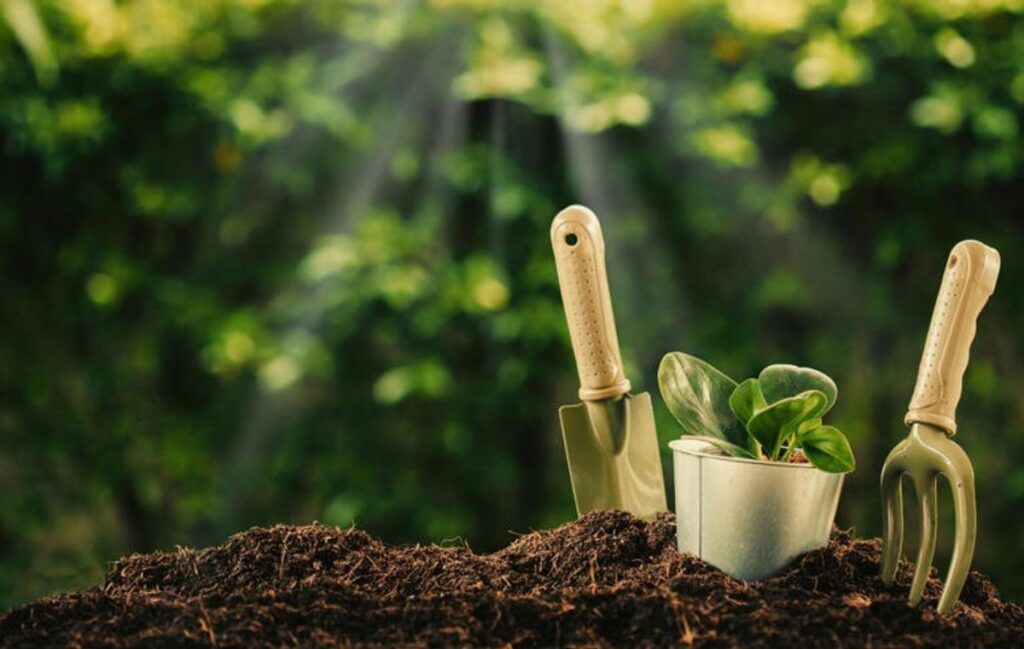Taking care of your garden is a source of beauty and pride for any homeowner. However, achieving that lush landscape requires a mix of knowledge and dedication. Understanding how to care for your garden involves recognizing the unique needs of your plants: how to adjust for temperature, water them properly, nourish them with compost and fertilizers, take care of their leaves and flowers, prevent and treat pests and diseases, as well as understand the importance of pruning and regular maintenance. In this article, we’ll explore each of these aspects to help you keep your plants in tip-top condition.
Take care of your garden. Key Takeaways:
- Assessing your garden’s climate and soil is crucial for plant survival and growth, with particular attention to temperature impacts and soil quality improvement using organic matter.
- Effective watering and nourishment techniques are essential, including proper watering practices, wise use of compost and fertilizers, and monitoring soil moisture and nutrient levels.
- Maintaining plant health requires regular pruning, garden clean-up, and proactive measures to prevent common diseases and pests.
- Taking care of your garden areas, such as raised beds, containers, and landscapes, need specialized care to thrive, taking into account their unique conditions and requirements.
- Seasonal gardening tasks must be tailored to the time of year, with specific activities for spring preparation, summer maintenance, fall cleanup, and winter preparation and to Take care of your garden.
Understanding Your Garden’s Climate and Soil (the best way to Take care of your garden)

Assessing Temperature Impacts
Assessing the impact of temperature on your garden is crucial for ensuring plant health and vitals and to Take care of your garden. Most plants have an optimal temperature range in which they thrive, and understanding this can help you make informed decisions about plant selection and care. It’s important to maintain a stable environment, as extreme temperature fluctuations can be detrimental to many plant species.
You can Take care of your garden if you accurately measure soil temperature, consider using a soil thermometer. Here’s a simple guide on how to use one effectively:
- Choose a thermometer that is easy to read and has a durable probe.
- Insert the probe into the soil at the recommended depth for the plants you are growing.
- Take readings at the same time each day to track temperature changes.
- Maintain your thermometer by regularly cleaning the probe to ensure accurate readings.
Remember, sudden changes in temperature can negatively affect plants and will negatively effect while Taking care of your garden. Keep them away from open doors and windows to avoid drafts and ensure that the ambient temperature remains consistent.
By monitoring temperature and making necessary adjustments, you can create a more conducive environment for your garden’s success.
Take care of your garden by Improving Soil Quality with Organic Matter
Enhancing your garden’s soil with organic matter is a pivotal step in ensuring long-term success and vitality. Adding compost or soil improvers can significantly improve moisture retention and nutrient transfer to your plants, especially during the challenging summer heat.
Organic materials like compost, coconut coir, and peat moss are excellent for absorbing water, which helps to maintain soil moisture during dry periods. Here’s a simple guide to get you started:
- Start a compost pile with kitchen scraps and yard waste.
- Regularly turn the compost to aid decomposition.
- Mix the mature compost into your garden soil.
By fostering a healthy environment for beneficial organisms such as microbes and worms, compost not only enriches the soil but also bolsters its structure and aeration, creating a robust foundation for your plants.
Remember, while compost provides a slow, steady release of nutrients, chemical fertilizers offer a quicker, more concentrated nutrient boost. It’s crucial to strike a balance that suits your garden’s specific needs.
Seasonal Soil and Climate Considerations
Understanding the seasonal dynamics of your garden’s soil and climate is crucial for its success. Seasonal changes can significantly influence the health and productivity of your garden. As the year progresses, different care and maintenance tasks become necessary to adapt to Take care of your garden in the changing conditions.
For instance, in the fall, it’s an ideal time to collect soil samples for testing to prepare for the next year’s fertilization. This helps in creating a tailored approach for different garden areas and plant types. Similarly, winter maintenance requires a gentle touch, such as avoiding walking on dormant or frozen lawns and using non-salt alternatives for de-icing.
By breaking down your seasonal landscape maintenance by time of year and plant type, you create an easy-to-follow schedule that ensures your garden thrives throughout the year.
Here’s a simple seasonal checklist to Take care of your garden:
- November: Experiment with cold-tolerant greens and season extension techniques.
- September: Plan for storage crops and end-of-season tasks.
- Winter: Lightly fertilize green lawns and practice careful lawn and plant maintenance to avoid damage.
Watering and Nourishment Techniques

Proper Watering Practices – essential to take care of your garden
Proper watering is essential to Take care of your garden and keep plants healthy and in good condition. The amount and frequency of watering vary depending on the type of plant and environmental conditions. It’s important to remember that overwatering can be just as harmful as underwatering. To determine the amount of water needed, it is advisable to check the soil moisture before watering again.
A simple way to do this is to stick a finger halfway into the soil and check if it’s wet or dry. If the soil is wet, it is best to wait before adding more water. This practice prevents root rot and other water-related issues that can arise from excessive moisture.
- Watering plants at the right time is essential to their growth and water retention. The optimal time to water plants is in the morning, while it’s still cool. This allows the water to reach the roots of the plants as it runs down into the soil without losing too much water to evaporation.
When considering how to water your garden for Taking care of your garden, it’s not just about the quantity of water but also the method of delivery. Hoses and watering cans are labor-intensive but provide a precise method to water plant bases beneath the leaves, leaving the surrounding soil dry. This restricts weed growth and ensures all water is absorbed where it is needed.
Recycling water from household use, such as from drinking glasses or cooking, is an ecological way to nourish your plants. By adopting these practices, you can ensure that your garden remains vibrant and healthy throughout the growing season.
Using Compost and Fertilizers Wisely
In the realm of gardening, compost and fertilizers are indispensable allies in nurturing plant life. Organic compost, such as homemade blends or manure, enriches the soil with vital nutrients and enhances its structure over time. This natural approach supports a thriving ecosystem for beneficial organisms like worms, which in turn bolsters plant health.
When incorporating fertilizers, precision is key. Chemical fertilizers offer a swift nutrient boosts, but must be used judiciously to avoid root damage and environmental harm. A soil analysis can guide gardeners in selecting the appropriate fertilizer, tailored to the plant’s specific needs and the soil’s nutrient profile.
- Conduct a soil test to identify nutrient deficiencies.
- Choose fertilizers that complement your soil’s needs.
- Apply organic compost to improve soil health and moisture retention.
- Follow the recommended application rates for chemical fertilizers to prevent overuse.
By integrating compost into your garden, you not only provide essential nutrients but also improve the soil’s ability to retain moisture, which is particularly beneficial during hot or dry spells.
Monitoring Nutrient Levels and Soil Moisture
To maintain a thriving garden, monitoring nutrient levels and soil moisture is crucial. Begin by collecting soil samples from various garden areas, as different plants and conditions may require distinct nutrient profiles. A simple method to assess soil moisture is to insert a finger halfway into the soil; if it’s wet, delay watering to avoid over-saturation and potential fungal diseases.
Regularly testing your soil’s nutrient content can prevent both deficiencies and excesses, which are detrimental to plant health. Utilize soil tests to guide your fertilization strategy, ensuring that you provide the right balance of nitrogen, phosphorus, or potassium as needed by your plants.
Remember, while Taking care of your garden fertilizers can quickly supply nutrients, they should be used judiciously to prevent root damage and environmental harm. Always follow the recommended application rates and consider the specific requirements of each plant species in your garden.
Plant Health and Maintenance

Pruning for Growth and Health
Pruning is a vital garden task that ensures the health and vitals of your plants. Proper pruning encourages better air circulation and light penetration, which are crucial for photosynthesis and preventing the overgrowth of weak branches. This strategic cutting back not only shapes the plant but also stimulates the production of new branches and flowers.
Each plant species has unique pruning requirements. Some may thrive with frequent trimming, while others require minimal intervention. It’s essential to understand the specific needs of your plants and to follow expert guidance for the best results. For instance, the Old Farmer’s Almanac suggests that the Moon’s phase and positioning can influence the best days to prune for encouraging growth.
Pruning is not just about cutting; it’s about caring for your plants to ensure their long-term health and beauty. Regular maintenance, including the timely removal of dead or diseased branches, can prevent many future problems and enhance your garden’s overall aesthetic.
Regular Garden Clean-Up – top secret to take care of your garden
Taking care of your garden and regular clean-up is not just about aesthetics; it’s about the health of your plants and the overall ecosystem of your garden. Regular clean-up is crucial to prevent the accumulation of debris, which can kill pests and diseases. A tidy garden also allows you to monitor plant health more effectively and ensures that your garden is a pleasant space for you to enjoy.
Regular garden maintenance includes tasks such as removing fallen leaves, clearing out weeds, and checking for signs of disease or pest infestation. It’s important to address these issues promptly to maintain a healthy garden environment.
Here are some essential tasks to keep in mind for garden clean-up:
- Remove dead plant material and debris to reduce the risk of disease.
- Prune dead or diseased branches to promote healthy growth.
- Keep the edges of your garden beds neat with pebbles or edging tools.
- Stay vigilant for garden pests and take action as soon as they are detected.
Remember, a little effort in garden clean-up can go a long way in preventing larger problems down the line.
Preventing Common Diseases and Pests
To safeguard your garden from the onslaught of pests and diseases, frequent inspection of your plants is key. Look for early signs of trouble such as discoloration, spots on leaves, or wilting. Early detection allows for prompt action, potentially saving your garden from widespread damage.
Keeping your garden clean and free from debris is not just about aesthetics; it’s a fundamental practice for disease and pest prevention. Regular maintenance, including pruning, can significantly reduce the risk of infestations.
When you do spot signs of pests or disease, isolation is crucial. Separate affected plants to prevent the spread to healthy ones. In severe cases, removing a diseased plant entirely may be necessary to protect the rest of your garden. Here’s a quick guide to managing common issues:
- Regular Cleaning: Remove fallen leaves and debris to minimize hiding spots for pests.
- Early Detection: Check plants weekly for any signs of pests or disease.
- Isolation: Keep diseased plants away from healthy ones to prevent cross-contamination.
- Pest Control Basics: Learn to identify and control pests early to avoid major infestations.
Remember, the health of your garden is an ongoing commitment. By staying vigilant and proactive, you can enjoy a vibrant, thriving garden season after season.
Special Care for Different Garden Areas

Caring for Raised-Bed Gardens
Raised-bed gardens offer excellent drainage, ease of maintenance, and can be a stylish addition to your gardening space. Proper care is essential to maximize the benefits of raised beds and ensure a bountiful harvest to Take care of your garden.
To maintain a healthy raised-bed garden, diversity is key. Including a variety of plants, such as flowers to attract beneficial insects, can enhance the ecosystem of your garden. Companion planting and crop rotation are also effective strategies to maintain soil health and prevent pest infestations.
When setting up your raised bed, consider using straw or cedar mulch on the soil surface to reduce evaporation and suppress weeds.
Here are some tips for soil and planting in raised beds:
- Use high-quality garden soil mixed with compost to fill your beds.
- Ensure smooth and level soil surface by raking and removing any debris.
- Space plants slightly closer than in traditional row gardens, as there’s no need for walkways.
- Start planting early in the season, as soil in raised beds warms up faster.
Remember, a raised bed should not exceed six inches in height without additional support to maintain structure and prevent soil compaction.
Container Garden Maintenance
Take care of your garden and Maintaining container gardens requires regular attention to ensure they thrive. Regular maintenance is key, involving tasks such as cleaning leaves, removing wilted flowers, and monitoring plant health. This proactive approach helps in preventing diseases and pests, and allows for early detection of any issues.
Frequent watering is essential for Taking care of your garden and container gardens, as they lack access to ground moisture. In hot and dry conditions, watering may be needed twice daily. It’s crucial to water thoroughly, ensuring all the soil is saturated, not just the edges.
Fertilization is another critical aspect of Taking care of your garden and container garden maintenance. Due to limited soil and frequent watering, nutrients can be quickly depleted. Regularly providing the right fertilizers will support robust plant growth.
Here are some additional tips for Taking care of your garden:
- Review and discard any soft or rotten bulbs during winter.
- Organize garden tools and check irrigation systems for any damage.
- Clear walkways of debris and repair any broken garden structures as needed.
Lawn and Landscape Management
Maintaining a healthy lawn and landscape is crucial for the overall appearance and Taking care of your garden also for ecosystem of your garden. Regular lawn care is essential for Taking care of your garden, including mowing, watering, and fertilizing. It’s important to mow regularly, leaving clippings on the lawn to act as a natural fertilizer and to remove only one-third of the grass height each time. As the season progresses, raise the mowing height to help your grass withstand heat and drought.
Watering your lawn and landscape wisely is not only beneficial for plant health but also for water conservation. Aim to water in the morning and soak the lawn until it receives about 1 inch of water per week.
For landscape maintenance, consider the following tasks:
- Clean and repair garden structures like cold frames as needed.
- Manage weeds between pavers and repair any cracks in pathways.
- Paint or stain outdoor building exteriors to protect them from the elements.
Take care of your garden In the fall, overseed new lawns or areas that need rejuvenation, and use a fall grass fertilizer to prepare your lawn for the colder months. Raking leaves and seasonal cleanup will not only keep your garden tidy but also prevent diseases and pests from overwintering in debris.
Seasonal Gardening Tasks

Spring Preparation and Planting
As the garden awakens from its winter slumber, spring preparation and planting are crucial for setting the tone for the rest of the year. Begin by assessing your garden’s needs: clear away debris, check for signs of winter damage, and repair any structural elements like trellises or fences. It’s also the perfect time to start planting early-season crops and flowers that can withstand the cooler temperatures.
Following a structured checklist can ensure you don’t miss any key steps. Here’s a simple guide to get your garden spring-ready:
- Plant garlic, shallots, and other cool-weather bulbs.
- Prepare trellis systems for climbing plants like tomatoes.
- Start hardening -off indoor-started plants for outdoor transplanting.
- Apply fertilizers to perennials as they begin new growth.
Remember, to Take care of your garden and a little proactive planning can make a significant difference as the season progresses. Use this time to collect soil samples for testing, which will guide your fertilization strategy for the year. Additionally, ensure all your garden tools are clean, sharp, and ready for use.
Embrace the new season with enthusiasm and diligence. The efforts you put in now will pave the way for a lush, vibrant garden that brings joy throughout the year.
Summer Care and Harvesting
Summer is a critical time for garden maintenance and to Take care of your garden also for harvesting. Regular monitoring and timely harvesting are key to ensuring a productive season. As temperatures rise, it’s important to invest in a Shade to protect your plants from the intense heat.
- Keep a close eye on your vegetables, such as beans, eggplant, peppers, and tomatoes, and harvest them before they overripen or a hard frost hits.
- Stay vigilant with watering, ensuring your plants receive adequate moisture without overwatering.
- Continue succession planting to maintain a continuous supply of crops.
In July, as your garden reaches its peak productivity, make sure to check on your crops frequently. This prevents overgrowth, rot, and pest problems, which can quickly escalate in the summer heat.
Remember to Take care of your garden and plan for storage of your harvest and consider the end-of-season tasks that will set you up for success in the coming year.
Fall Cleanup and Winter Preparation
As the vibrant colours of fall foliage give way to the bare branches of winter, gardeners should shift their focus to preparing their green spaces for the colder months ahead. Proper fall cleanup and winter preparation are crucial for ensuring the health and vitality of your garden come spring.
- Review and discard any wintering bulbs that are soft or rotten.
- Order seeds for the upcoming spring planting season.
- Apply a fast-acting fertilizer to flowers in regions with mild winters.
During this time, it’s also important to maintain the hardscape elements of your garden. Repair any broken structures such as arbors, organize your tools, and check irrigation systems for damage. Clearing walkways of snow and repairing stone walls can prevent accidents and further deterioration due to winter weather.
As you tidy up your garden, remember to cut back perennials, divide and replant overcrowded plants, and harvest vegetables before the first frost. A layer of mulch can protect the soil and plant roots from freezing temperatures. Avoid using rock salt for ice melting, as it can harm plant life; opt for safer alternatives like calcium chloride or potassium.
Conclusion
In conclusion, taking care of your garden is a rewarding endeavor that requires attention to detail and a willingness to learn. From understanding the specific needs of your plants in terms of temperature and hydration to enriching the soil with compost and fertilizers, every step is crucial for a thriving garden. Regular maintenance, such as pruning, pest control, and disease treatment, ensures the longevity and beauty of your plants. Whether you’re tending to a raised-bed garden, container plants, or a sprawling backyard oasis, the joy of watching your garden grow is immeasurable. Remember, gardening is not just about the end result; it’s about the journey of nurturing and connecting with nature. So, keep your gardening notebook handy, stay curious, and enjoy the process of helping your garden flourish.
Frequently Asked Questions
How can I assess the impact of temperature on my garden?
To assess temperature impacts, monitor local weather patterns and understand the hardiness zone of your area. Keep track of seasonal temperature changes to select plants that can thrive in your garden’s climate.
What can I do to improve soil quality with organic matter?
Enrich your soil by adding organic matter such as compost or soil improvers. This will enhance moisture retention and nutrient transfer, and help your garden withstand the stress of summer heat.
What are the best watering practices for my garden?
Water your plants deeply and less frequently to encourage deep root growth. Water early in the morning to reduce evaporation and avoid wetting the foliage, which can lead to fungal diseases.
How should I use compost and fertilizers in my garden?
Apply compost to enrich the soil and use fertilizers judiciously, based on the specific needs of your plants. Conduct soil tests to determine nutrient levels and adjust your fertilization strategy accordingly.
What are some effective ways to prevent common garden diseases and pests?
Prevent diseases and pests by practising good garden hygiene, such as removing plant debris and diseased foliage. Use appropriate organic or chemical treatments as needed and encourage beneficial insects.
How do I take care of garden?
Maintain your raised-bed garden by using quality soil and mulching to reduce weeds and evaporation. Monitor for pests and diseases, and ensure adequate watering and nutrient supply for optimal plant health.
You can also read our blogs on What Is The Latest Technology In The World Right Now? | WHAT Exactly Is DIY? HOW YOU CAN DO IT | How Cargo Ships Are Made?








Thank you for your sharing. I am worried that I lack creative ideas. It is your article that makes me full of hope. Thank you. But, I have a question, can you help me?
Thank you for your sharing. I am worried that I lack creative ideas. It is your article that makes me full of hope. Thank you. But, I have a question, can you help me? https://accounts.binance.com/es-MX/register?ref=JHQQKNKN